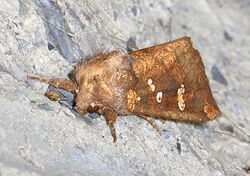Biology:Papaipema duovata
From HandWiki
Revision as of 08:00, 17 July 2021 by imported>Jport (linkage)
Short description: Species of moth
| Papaipema duovata | |
|---|---|

| |
| Adult | |
| Scientific classification | |
| Domain: | Eukaryota |
| Kingdom: | Animalia |
| Phylum: | Arthropoda |
| Class: | Insecta |
| Order: | Lepidoptera |
| Superfamily: | Noctuoidea |
| Family: | Noctuidae |
| Genus: | Papaipema |
| Species: | P. duovata
|
| Binomial name | |
| Papaipema duovata (Bird, 1902)
| |
| Synonyms | |
| |
Papaipema duovata, the seaside goldenrod stem borer or seaside goldenrod borer, is a moth that is native to North America, where it is found in the coastal plain from the gulf coast north to at least New Jersey. The species is listed as threatened in Connecticut.[2][3] It was described by Henry Bird in 1902.
The wingspan is about 36 mm. Adults are dusky brown, with white reniform, orbicular and claviform spots and dull yellow basal spots. Adults are mainly on wing in October.
The larvae bore into Solidago sempervirens.[4]
References
- ↑ Savela, Markku. "Papaipema duovata (Bird, 1902)". http://ftp.funet.fi/pub/sci/bio/life/insecta/lepidoptera/ditrysia/noctuoidea/noctuidae/xyleninae/papaipema/#duovata. Retrieved January 11, 2018.
- ↑ "Connecticut's Endangered, Threatened and Special Concern Species 2015". State of Connecticut Department of Energy and Environmental Protection Bureau of Natural Resources. Retrieved January 10, 2018.
- ↑ "932496.00 – 9465 – Papaipema duovata – Seaside Goldenrod Borer Moth – (Bird, 1902)". Moth Photographers Group. Mississippi State University. Retrieved January 11, 2018.
- ↑ "Species Papaipema duovata - Seaside Goldenrod Borer - Hodges#9465". BugGuide. Retrieved January 11, 2018.
External links
- Original description as Hydroecia duovata: Bird, Henry. (May 1902). "New Histories and Species in Hydroecia". The Canadian Entomologist. 34(5):115.
Wikidata ☰ Q13510889 entry
 |

